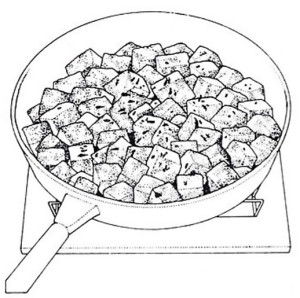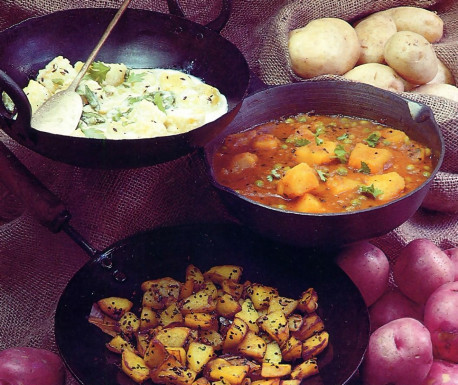One Potato, Two Potato, Three…
Or—pick any vegetable, choose one of these three cooking methods,
and you’re on your way to creating a unique main or side dish.
by Visakha-devi dasi
This month, I’d like to discuss three basic ways of cooking vegetables. As you become thoroughly conversant with these three basic methods and as you observe how each method affects the ingredients you will learn how to vary the final taste, texture, and appearance of the dish. The characteristics of a particular vegetable determine for you whether it should be cooked until it is tender-crisp, butter-soft, or pureed.
METHOD 1 makes dry-textured vegetable dishes. Small, uniform pieces of vegetable are briskly sauteed in ghee (clarified butter) and then cooked to tenderness without adding any liquid. If the particular vegetables that you’re cooking have substantial moisture content, you can stir-fry them until they’re tender-crisp and softly browned. But if the vegetables are dry or starchy, then set the flame to medium-low, cover the pan, and allow the vegetables to cook in the ghee and their own juices until butter-soft.
METHOD II makes butter-soft braised vegetable dishes. Here you briskly sautee the vegetables, add a liquid, and continue cooking (covered, on low flame) until the vegetables are very tender. Use this method for making vegetable stew, vegetables in gravy, moist vegetables in a concentrated glaze or sauce, or crusty, tender vegetables coated with seasoned ghee,
METHOD III makes vegetables in seasoned butter, sauce, or broth. Unlike the first two methods, where the vegetables were sauteed before being cooked to tenderness, this time you first cook them to near tenderness and then sautee them. Depending on the vegetable, you may boil it, steam it, pressure cook it, oven or coal bake it, or deep or shallow fry it. You may cook it either whole or cut, peeled or unpeeled. If you cook it whole, you afterwards cut it into uniform pieces and quickly sautee them in seasoned ghee on a medium high flame. This improves texture and flavor. You can further enhance the finished vegetable by swirling it in a prepared sauce, sprinkling it with more butter and lemon juice, or floating it in a delicate broth.
To put these three methods into practice, I’m taking that all-around vegetable, the potato, and cooking it each way. The three results are illustrated in the photo, and the three recipes above explain the steps involved. Depending on the spices and herbs that you’ve got, pick one of the three lists of seasonings and prepare the potatoes using the same seasonings for each method. Then you can see the differences created just by varying heat, timing, and the sizes and shapes of the vegetable pieces. With variations in ingredients and seasonings, it’s easy to see how you can create innumerable main or side dishes with any vegetable.
The devotee loves making varieties o dishes and offering them to Lord Krsna And the Lord reciprocates many time over by offering His love to the devotee Thus Lord Krsna’s cuisine is an exchange of love. And out of that loving exchange come the most delicious dishes you could ever imagine.
(Recipes by Yamuna-devi dasi)
Three Methods for Cooking Vegetables
 Choose one of the combinations of ingredients below—essential, basic, or gourmet—and, using it each time, prepare potatoes with METHOD 1, then METHOD II, and then METHOD III.
Choose one of the combinations of ingredients below—essential, basic, or gourmet—and, using it each time, prepare potatoes with METHOD 1, then METHOD II, and then METHOD III.
Essential seasoning ingredients:
1 pound peeled potatoes (about 3 medium-size)
3 tablespoons ghee (clarified butter) or vegetable oil
¼ to 2 dried red chili pods, broken into bits
¼ teaspoon turmeric
about ½ teaspoon salt
1 to 2 ½ cups water (for METHODS II and III)
2 tablespoons fresh coriander or parsley leaves, minced
¼ teaspoon sugar
Basic seasoning ingredients:
1 pound peeled potatoes (about 3 medium-size)
3 tablespoons ghee or oil
1 tablespoon peeled, fresh ginger root, minced fine
1 tablespoon seeded hot green chilies, minced fine
1 teaspoon cumin seeds
¼ teaspoon turmeric
½ tablespoon ground coriander
about ½ teaspoon salt
1 to 2 ½ cups water (for Methods II and III)
2 tablespoons fresh coriander or parsley leaves, minced
¼ teaspoon sugar
Gourmet seasoning ingredients:
1 pound peeled potatoes (about 3 medium-size)
3 tablespoons ghee or oil
1 tablespoon peeled, fresh ginger root, minced fine
1 tablespoon seeded hot green chilies, minced fine
1 teaspoon cumin seeds
¼ teaspoon mild asafetida powder
½ teaspoon black mustard seeds
¾ teaspoon turmeric
½ tablespoon ground coriander
about ½ teaspoon salt
1 to 1 ½ cups water (for Methods II and III)
½ tablespoon lemon juice
2 tablespoons fresh coriander or parsley leaves, minced
¼ teaspoon sugar
METHOD I:
Dry-Textured Potatoes
1. Cut the potatoes into ½-inch cubes. Heat the ghee or oil in a heavy frying pan over a medium-high flame until a haze forms over the ghee’s surface. Drop in the seeded green or red chilies, whole spice seeds, and minced ginger root (optional). Fry the spices until they reach the desired shade of brown. Add the potatoes and fry, stirring frequently to prevent burning, until they are partially cooked and slightly browned.
2. Reduce flame to medium-low, sprinkle in the powdered spices and salt, add half of the fresh herbs, then loosely cover and cook until the potatoes are tender. Stir in the remaining herbs, the sugar, and the lemon juice (optional). Fry for one or two additional minutes to evaporate any remaining liquid.
METHOD II:
Dry-Textured, Tender Braised Potatoes
1. Cut the potatoes into 1-inch cubes. Heat 2 ½ tablespoons of ghee or oil in a heavy 4- to 6-quart saucepan over medium-high to high flame until a drop of water flicked into the pan instantly dances. Drop in the seeded green or red chilies, whole spice seeds, and minced ginger root (optional). Fry the spices until they reach the desired shade of brown. Stir in the potato cubes and cook, stirring frequently to prevent burning, until they are about 1/3 cooked and gently browned.
2. Drop in the powdered spices, the salt, half of the fresh herbs, and about 1 ¼ cups water. Reduce the flame to medium-low, then gently boil the potatoes until they are tender and the water has nearly evaporated. Stir in the remaining ½ tablespoon of ghee, the sugar, and the lemon juice (optional). Then raise the flame to medium-high and fry until the vegetable is dry and slightly crisp. Remove the pan from the flame and fold in the remaining freshly minced herbs.
METHOD III:
Steamed Potatoes, Pan-Fried with Seasonings
1. Cut the potatoes into ¼ inch cubes and place them in a vegetable steamer tray inside a large saucepan. Cover and steam the potatoes over boiling water until they are soft and tender throughout, but not mushy.
2. Heat the ghee or oil in a 10- or 12-inch heavy frying pan over medium-high flame until a haze forms over the surface. Drop in the seeded red or green chilies, whole spice seeds, and minced ginger root (optional). Fry the spices until they reach the desired shade of brown. Add the steamed potatoes, powdered spices, and salt, sugar, and lemon juice (optional). Reduce the flame slightly and stir-fry the potatoes until they are browned. Remove the pan from the flame, and mix in the freshly minced herbs.
Here are a few practical suggestions to bring out the best in your vegetable cookery. Generally, try to select small, firm vegetables, as fresh as possible.
To help retain nutrients and freshness, store your vegetables untrimmed and unwashed in a refrigerator or cold cellar. Clean them just before cooking.
To help remove astringency or bitterness from certain vegetables, wash and trim them, cut them into pieces, sprinkle them with salt, and let them sit aside for 30 to 60 minutes. Finally, squeeze the moisture out of the vegetable. Some vegetables should then be washed again and fully dried before they are used.
Try to prepare only as many vegetables as you will need, and as far as possible, serve them as soon as they are cooked. Vegetables tend to lose flavor if they are reheated quickly or kept warm for long periods of time. If you must reheat vegetables, use a medium flame rather than high.
Fresh, natural vegetables keep their fresh, natural vegetable flavors when they are steamed, cooked in dry heat, cooked quickly, or boiled whole and unpeeled until tender, and immediately seasoned with ghee.
Avoid cooking spinach or fresh greens in aluminum or cast iron, for the vegetables easily absorb the flavor of these metals. Stainless steel, nonstick cookware, and enamaled cook-ware are ideal for this purpose.
To remove strong flavors from broccoli, cabbage, or brussels sprouts, blanch the vegetables for 4 to 6 minutes, plunge them into cold water to stop them from cooking, then proceed with normal preparation.


Leave a Reply